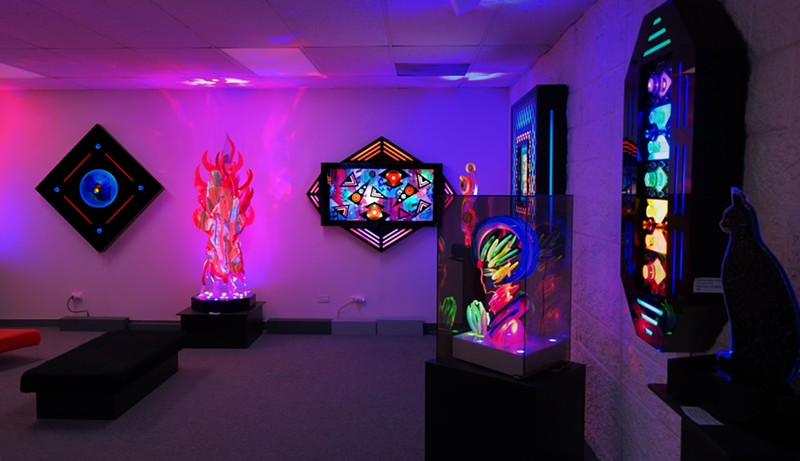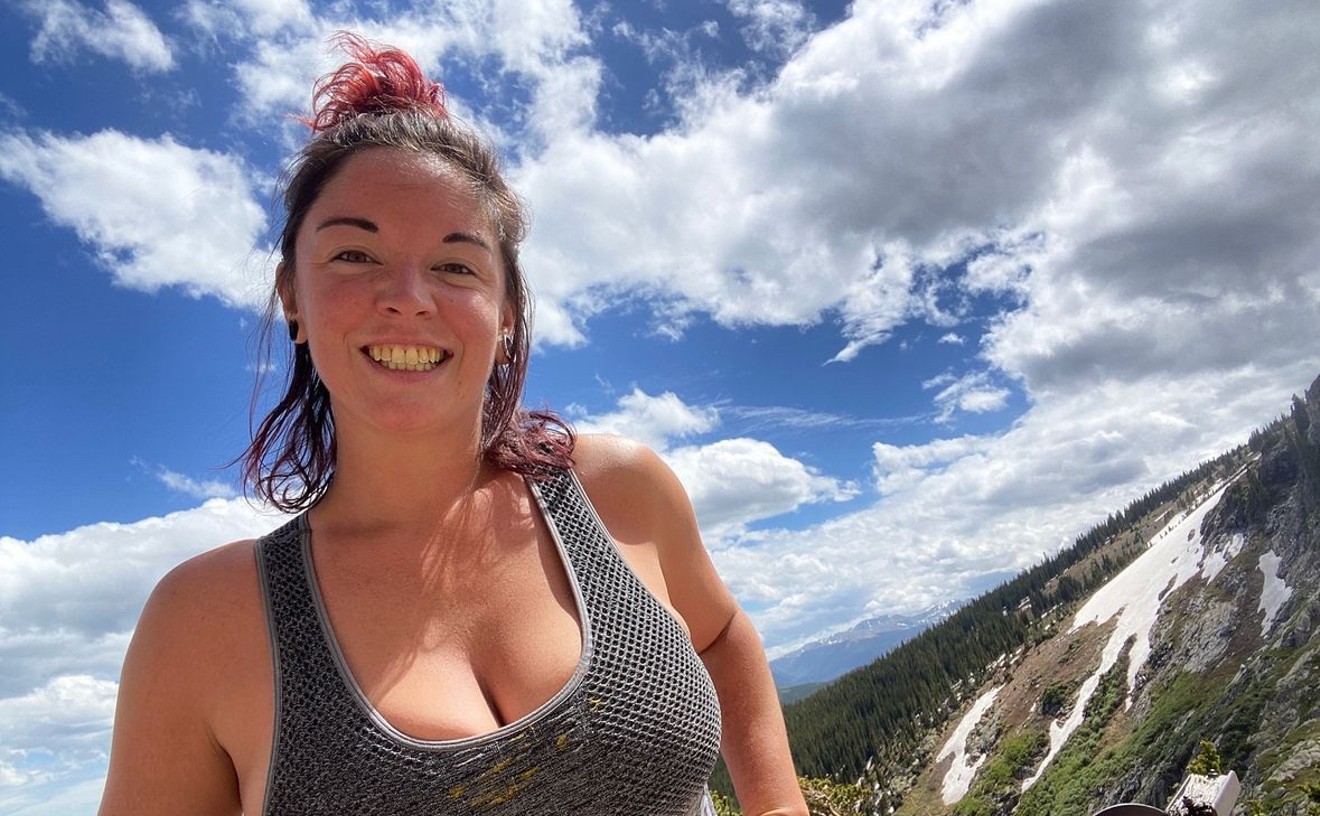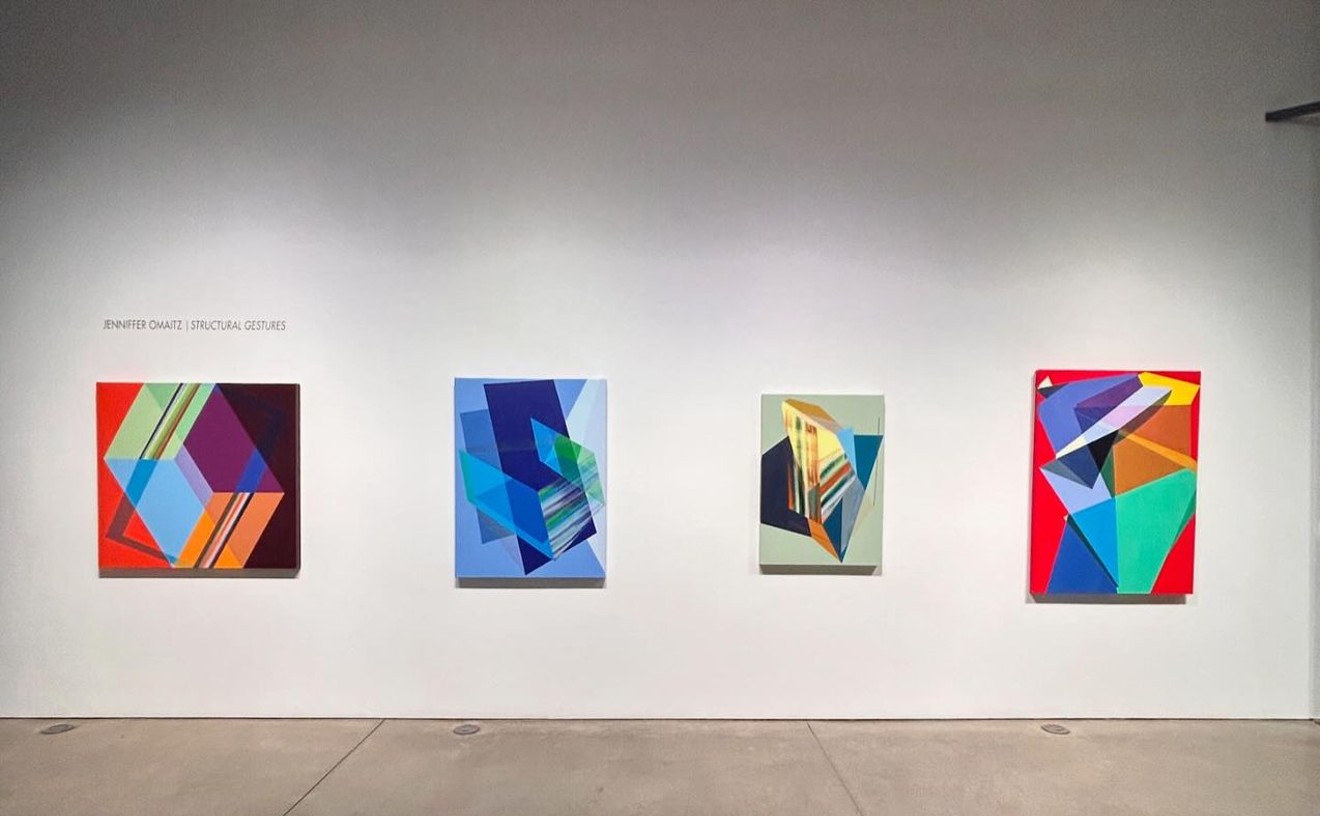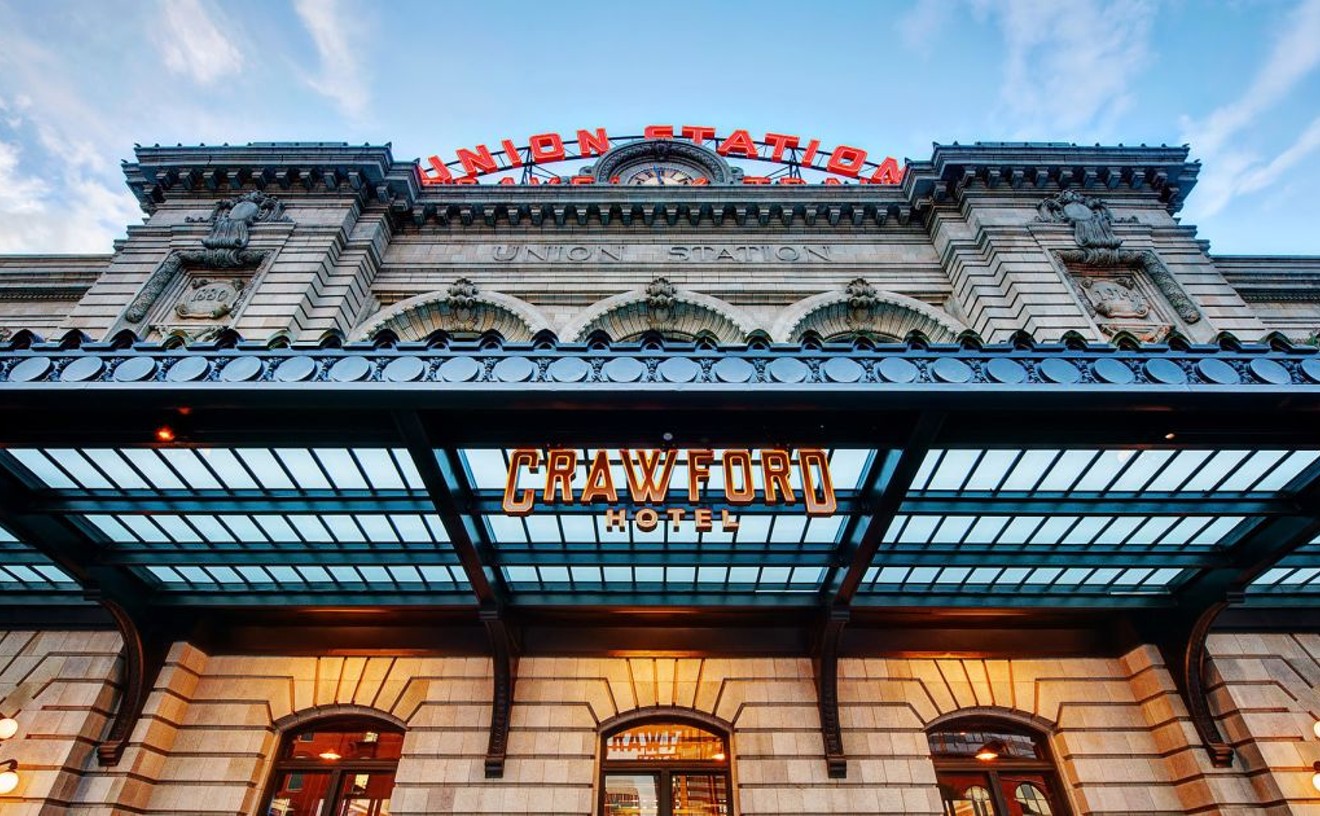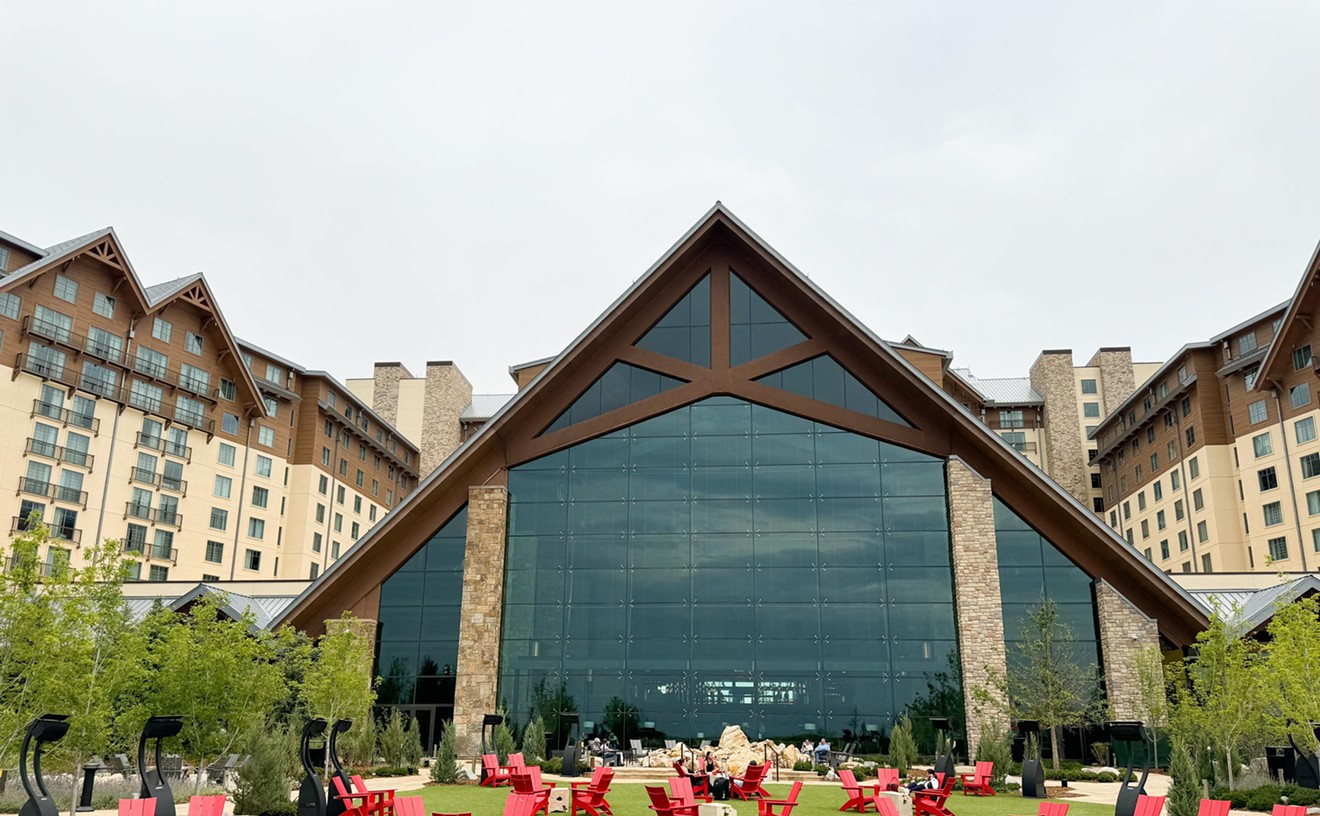Lumonics — the word used for the light sculptures and immersive art performances that the Tanners produced — was coined in 1970 by a student working for the University of Miami newspaper who found illumination and harmonics merging in the work at the Tanners' Miami studio. The idea for the first immersive event came after Mel had a sudden mystical experience. He was walking through a parking lot “looking up at an airplane flying above, and then seeing his reflection on the other side of the parking lot looking back at him,” Raphael recounts. “It was like he tripped into another dimension, and it changed his personality from being a reserved person to plugging into an expanded universe and being much more outgoing.”
After that, the Tanners decided to use their art to take people on an internal journey by turning their studio into a performance space where music, light and art would interact with the subconscious. Performances involved participants lounging while plexiglass sculptures pulsated with light in tandem with psychedelic video and music. “Dorothy used to call it a vacation from yourself,” Raphael remembers.

A screen above Lumonics sculptures is illuminated by video produced by Dorothy Tanner and Marc Billard.
Marc Billard
Mel and Dorothy met in Brooklyn while they were both studying art at the Brooklyn Museum school; Mel, a World War II veteran, studied painting, while Dorothy was adept at sculpture, woodcarving and drawing. They married in 1951, then founded the Syracuse Art Workshop, where they taught sculpting and painting while also exhibiting their work at various galleries in New York City. Feeling the urge to create and exhibit art full-time, the Tanners closed the workshop in 1963 and returned to Manhattan, where they founded an artist co-op before closing it two years later in order to travel around Europe.
They returned to the U.S. in 1966 and settled in Miami. That’s where they first began to work with light and sculpture, a medium that was already taking off through the Light and Space Movement and such trailblazing artists as Yayoi Kusama, Bruce Nauman and James Turrell. Performance art and immersive experiences were also becoming popular in the avant-garde scene — though not as popular as they are today, teeming with Instagram hordes.
In 1970, the Tanners turned their studio into the Lumonics Light and Sound Theatre. It was one of the first light-art galleries in the country, and they offered their immersive performances there. “After an article in the Miami Herald called it ‘one of the most unusual yet beautiful experiences in the world of art,’ Lumonics attracted an audience that continued to grow,” Raphael recalls.
The Tanners got help from their friends to bring these events to life. “An electronics person they met built them a color organ so that they could connect all the light sculptures to music," Raphael says. "A couple of young guys who had done light shows for music groups gave them carousel slide projectors and overhead projectors. The Tanners created hundreds of slides and about 100 overhead projector trays that they projected on a large wall and created live, one-of-a-kind paintings with oils.”
Those who helped the Tanners soon became part of a collective that included Raphael, artist/composer Marc Billard and Barbara Billard, the gallery’s technical assistant. The three were introduced to the Tanners in 1972 through mutual friends and, drawn by the healing mission that the couple espoused, they've been part of Lumonics ever since. “It’s been our life,” Raphael explains.
In 1979, the collective moved to San Diego, where the group put on Lumonics performances in a rented house. From there, the group moved to Bangor, Maine, then Boston, then Fort Lauderdale in 1985. Mel passed away in 1993, but Dorothy and the rest of the Lumonics collective kept his mystical vision alive by continuing to host immersive performances.
But by 2005, Raphael recalls, "we were ready for a change.” The collective scouted locations from Asheville to San Francisco, “but they didn’t feel right for us," he says. "Two couples we knew had relocated to Denver, and they thought it would be a great place for Lumonics. … That Colorado was cannabis-friendly was especially important to Dorothy." In 2008, the collective came to Denver, and Lumonics soon became an integral part of the city's art scene.
At first, Dorothy and Marc Billard were hesitant about hosting performances, since their Denver studio was smaller than previous locations. Instead, the Lumonics Light and Sound Gallery was largely sustained by offering music performances and gallery tours, exhibiting art around town and teaching the mechanics behind light sculpture through the Lumonics School of Light Art, founded in 2018. That was the same year that Dorothy was awarded the Denver Mayor's Award for Innovation in the Arts.
Dorothy Tanner passed away in July 2020 at the age of 97. After that, the collective started "thinking about the best ways to continue Lumonics,” Raphael explains. “We decided to do a free Second Sunday tour, which we started in the summer, and it has been so well received that we have continued it.”
But the best tribute to the Tanners, Raphael and the Billards decided, would be an immersive performance. The collective hosted two editions of Lumonics Immersed this fall, and another is set for November 27. The primary aspect that separates Lumonics Immersed from other immersive art experiences is its intention, which is “to provoke a thought or emotion or state of euphoria rather than provide pure entertainment,” Raphael says.
That intention is certainly achieved during a performance. As the lights are dimmed, a screen hanging over several prominent light sculptures fills with kaleidoscopic images (somewhat reminiscent of a screensaver) that move with Dorothy and Marc’s transcendent music, which incorporates chanting, heartbeats and breathing sounds. After just fifteen minutes of watching the glowing lights synchronized to ethereal music, a sense of peace and calm washes over you.
"The audience we are seeking are adventurous people," Raphael says. "Explorers looking to expand their horizons." “We want you to lose sense of time,” Marc says. “That’s been one of the things about Lumonics…when people experience [the immersive performance], a lot of people have lost time. It doesn’t matter anymore.”
In Florida, they recall, psychiatry professors would bring their students to the immersive performances so that they could experience the loss of time. One professor took his graduate students because “he was having trouble hypnotizing them,” Raphael says, but the performance did the trick.
“It takes people out of themselves…for some people, it changes their life,” Marc says. “Just keep an open mind.”
Raphael hopes that adding immersive performances will bring in revenue needed to sustain the gallery. “We prefer exhibiting rather than selling the artwork, but sometimes we need to, just to continue to cover the expenses of maintaining the collection,” he says. “That's why we're excited about the Lumonics Immersed event. It introduces the public not only to the light art of the Tanners, but to the light and sound experience that has had such a profound effect on people since its inception.”
But Lumonics Immersed isn't the the only project that the collective has in the works to carry on the Tanners' legacy. “New outdoor sculptures are being designed by Marc Billard based on the work of Mel and Dorothy Tanner," Raphael says. "This is an avenue that the Tanners wanted to pursue in the past. LED lighting has made that possible now. We have also selected some of the artworks to be reproduced as limited editions.”
Those limited-edition works include re-creations of Dorothy’s sculpture “The Chalice” and three different versions of “The Cat,” reproduced with ten editions of each that can be bought online or in the gallery. Last summer, the Museum of Outdoor Arts in Englewood purchased a sculpture that is now at Fiddler’s Green, and a few sculptures are currently on display at Children’s Hospital Colorado.

Mel and Dorothy Tanner's light art can be found and purchased in Gallery Galleri at Meow Wolf.
Marc Billard
“Lumonics are an old-school collective of artists that we respect and have followed for years,” says Annie Geimer, Meow Wolf’s Denver artist liaison. “We have wanted to collaborate with them, and the first gallery show seemed like a great fit.” After this inaugural exhibit, Galleri Gallery shows will rotate every few months.
Meanwhile, the Lumonics Light and Sound Gallery will keep doing what it takes to survive. “One goal for the future is to utilize all the art, including what is in storage, and have it in one large space as a performing/museum/community event center,” Raphael says. “It would also include our Lumonics School of Light Art and workshop. Having all the artwork in one location would truly be a powerful experience.”
But for now, the current gallery will keep hosting visitors as well as classes and performances. “If Lumonics Immersed is as well received as it has been so far, and more people know about it, we can present this more frequently, even once a week — and each performance is unique,” Raphael says. “That exchange of energy with the community would provide a support system for our continuation and keep the spirit of Lumonics alive."
Lumonics Immersed will run from 8 to 10 p.m. Saturday, November 27, at the Lumonics Light and Sound Gallery, 800 East 73rd Avenue. Tickets are $20 and can be purchased on the website. The gallery asks that all guests be vaccinated; masks are optional.

